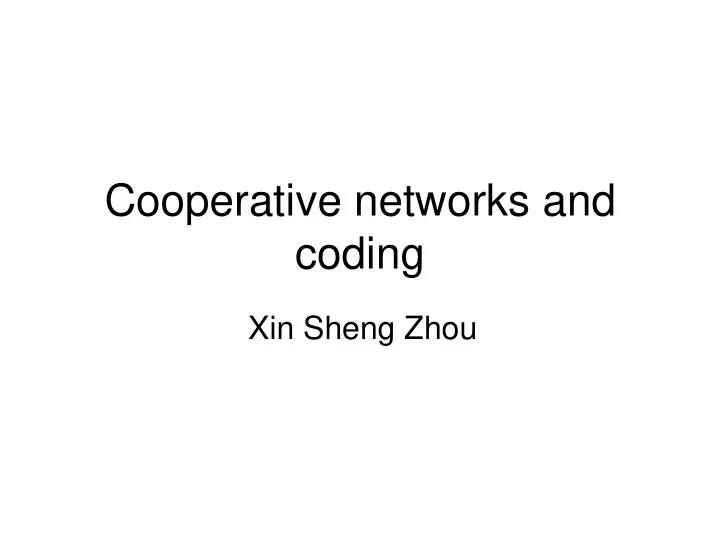

Cooperative networks and coding Xin Sheng Zhou
Problem for Wireless Networks • Traffic demand • Main problem: Shared medium = Interference
What we have done? • Wireless throughput had doubled every 30 months over a period of 104 years, or a million-fold increase since 1957 – 25-fold from wider spectrum – 1600-fold from reduced cell size – 5-fold from dividing the spectrum into smaller slices – 5-fold from better modulation scheme
Why reduced cell size? • Assume received SNR unchanged at the edge of the cell • Reduced cell size means reduced transmitting power • SINR does not change = Capacity unchanged for single user • Network capacity increased because more users can be served • When power is reduced compared to the noise level, the capacity for single user also reduced P log 1 I N 5W 5W 40W 40W 5W 5W 5W 5W 5W 5W
How can we deal with interference? • Do not care about other users and consider them as interference/noise – When we do not need that information, e.g. mobile user receives signals from other cells • Try to understand/decode other users message and cancel the interference – When we need both of them. E.g. Uplink at the base station from multiple users • If we do not need the interfering information, would it be benefit if we decode the interference first? Especially in cooperative networks
Interference effect • Total rate • Average rate per sender
FDMA
TDMA • Naïve TDMA • Modification – If user uses half time, it can uses double power and still maintain the average power – Same capacity region as FDMA
Successive decoding • Decode user 2 and consider user 1 as noise • Subtract signal from user 2 and decode user 1
CDMA
CDMA (2)
Heterogeneous networks • To improve network capacity – Existing solution: Cell splitting – New approach: Heterogeneous networks • Low power nodes are overlaid within a macro network with the same frequency
Heterogeneous networks • Heterogeneous networks – Interference management • Power control • Time-frequency resource partitioning and allocation – DL: OFDM, UL: SC-FDMA – Cell range expansion • Cell handover biasing for load balancing • Adaptive resource partitioning among different node power classes – Interference cancellation receiver
Base station Relay f D f U Relay node • Relay node f D f U – In-band: backhaul link Mobile user and access link use the same frequency R R (UL and DL still use different frequency) – Half duplex: time DL division on backhaul link and access link M – Full duplex: Spatial B M B separation, or R R interference cancellation UL M B M B
Half-duplex 2-phase 2-way RC n 3 n 2 n 1 R R 1 2 t • Two source nodes communicate with each other with the help of the relay node • No direct link between two source nodes • Example: Satellite communications • Modeled as two phases
Half-duplex 2-phase 2-way RC Achievable rate region DMC AWGN P P min{ ( ; | ), ( , )} R I X Y X I X Y 1 3 min , R C C 1 1 3 2 3 2 1 N N 3 2 min{ ( ; | ), ( , )} R I X Y X I X Y 2 2 3 1 3 1 P P 2 3 ( , ; ) min , R R I X X Y R C C 2 1 2 1 2 3 N N 3 1 P P 1 2 R R C 1 2 N 3 T. Oechtering, C. Schnurr, I. Bjelakovic, and H. Boche, “Achievable rate region of a two phase bidirectional relay channel," in Proc. 41st Annu. Conf. Information Sciences Systems, Mar. 2007, pp. 408-413.
LDPC codes factor graph for MAC • Multiple access channels Y X X Z 3 1 2
Half-duplex 3-phase 2-way RC n 3 n 2 n 1 R R 1 2 t • Direct link between two sources • Example: Cellular networks • Modeled as three phases
Half-duplex 3-phase 2-way RC Achievable rate region DMC AWGN P P P min{ ( ; ), ( ; ) ( ; )} R I X Y I X Y I X Y 1 3 1 min , R C C C 1 1 3 3 2 1 2 1 N N N 3 2 2 min{ ( ; ), ( ; ) ( ; )} R I X Y I X Y I X Y 2 2 3 3 1 2 1 P P P 3 2 2 min , R C C C 2 N N N 3 1 1
Joint encoding for 2-way RC • Joint encoding at the relay node • Generate additional check bits Generated by node 3 Received from node 1 Received from node 2
Joint decoding for 3-phase 2-way RC • Decoding based on three parts – Signal received from the source node – Signal received from the relay node – Its own message as side Joint decoding at node 1 information Message 1 Message 2 Additional check bits
Simulation results for 3-phase 2-way RC • (1920,640) LDPC codes • Signal-to-noise ratios are the same in two receiving phases • E b : Energy per bit from the source node
Thank you! Any questions and comments are welcome!
Recommend
More recommend